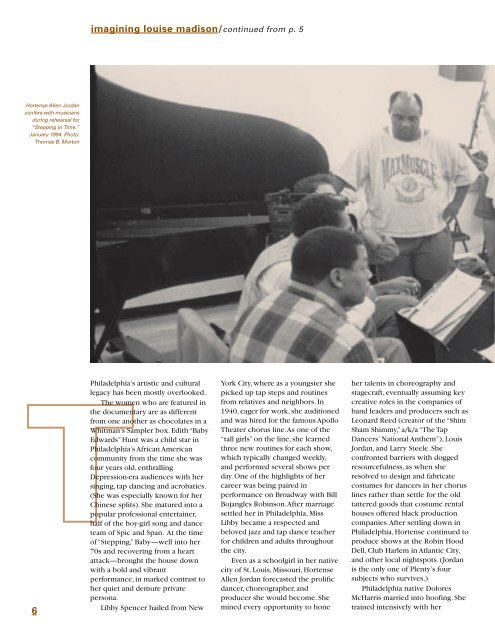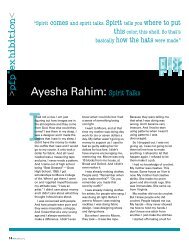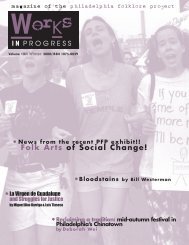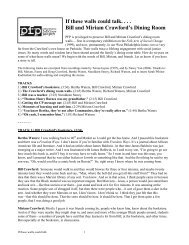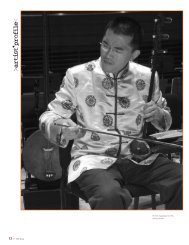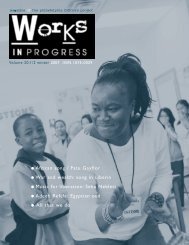View PDF - Philadelphia Folklore Project
View PDF - Philadelphia Folklore Project
View PDF - Philadelphia Folklore Project
- No tags were found...
You also want an ePaper? Increase the reach of your titles
YUMPU automatically turns print PDFs into web optimized ePapers that Google loves.
imagining louise madison/continued from p. 5Hortense Allen Jordanconfers with musiciansduring rehearsal for“Stepping in Time.”January 1994. Photo:Thomas B. MortonT<strong>Philadelphia</strong>’s artistic and culturallegacy has been mostly overlooked.The women who are featured inthe documentary are as differentfrom one another as chocolates in aWhitman’s Sampler box. Edith “BabyEdwards” Hunt was a child star in<strong>Philadelphia</strong>’s African Americancommunity from the time she wasfour years old, enthrallingDepression-era audiences with hersinging, tap dancing and acrobatics.(She was especially known for herChinese splits). She matured into apopular professional entertainer,half of the boy-girl song and danceteam of Spic and Span. At the timeof “Stepping,” Baby—well into her70s and recovering from a heartattack—brought the house downwith a bold and vibrantperformance, in marked contrast toher quiet and demure privatepersona.Libby Spencer hailed from New6York City, where as a youngster shepicked up tap steps and routinesfrom relatives and neighbors. In1940, eager for work, she auditionedand was hired for the famous ApolloTheater chorus line.As one of the“tall girls”on the line, she learnedthree new routines for each show,which typically changed weekly,and performed several shows perday. One of the highlights of hercareer was being paired inperformance on Broadway with BillBojangles Robinson.After marriagesettled her in <strong>Philadelphia</strong>, MissLibby became a respected andbeloved jazz and tap dance teacherfor children and adults throughoutthe city.Even as a schoolgirl in her nativecity of St. Louis, Missouri, HortenseAllen Jordan forecasted the prolificdancer, choreographer, andproducer she would become. Shemined every opportunity to honeher talents in choreography andstagecraft, eventually assuming keycreative roles in the companies ofband leaders and producers such asLeonard Reed (creator of the “ShimSham Shimmy,” a/k/a “The TapDancers’ National Anthem”), LouisJordan, and Larry Steele. Sheconfronted barriers with doggedresourcefulness, as when sheresolved to design and fabricatecostumes for dancers in her choruslines rather than settle for the oldtattered goods that costume rentalhouses offered black productioncompanies.After settling down in<strong>Philadelphia</strong>, Hortense continued toproduce shows at the Robin HoodDell, Club Harlem in Atlantic City,and other local nightspots. (Jordanis the only one of Plenty’s foursubjects who survives.)<strong>Philadelphia</strong> native DoloresMcHarris married into hoofing. Shetrained intensively with her


